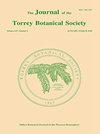Effects of individual bunchgrasses on potential C and N mineralization of longleaf pine savanna soils1
IF 0.8
4区 生物学
Q4 PLANT SCIENCES
引用次数: 7
Abstract
WEST, J. B. AND L. A. DONOVAN. (Department of Plant Biology, University of Georgia, Athens, GA 30602). Effects of individual bunchgrasses on potential C and N mineralization of longleaf pine savanna soils.3 J. Torrey Bot. Soc. 131:120-125. 2004.-A recent conceptual model of grasslands in the US argues that, because of the discontinuous cover of plants in systems strongly limited by precipitation, the presence or absence of individual plants has significant effects on soil processes, with relatively small effects of species differences. In systems not strongly limited by precipitation, resource limitations are thought to vary in space and time, vegetation is more continuous, and species differences are relatively more important. We ask whether the model can be applied to grass species effects on potential net C and N mineralization in a southeastern US savanna ecosystem. These savannas have very sandy soils, strong soil resource limitations, and discontinuous plant cover, even though they receive 1200 mm yr-' rainfall. Based on the discontinuous herbaceous vegetation, an extension of the model would predict that native perennial bunchgrasses would have strong plant presence effects, and small or no species identity effects on these soil processes. Soils were sampled in a paired fashion, directly under a plant (either Aristida stricta, Schizachyrium scoparium, or Andropogon ternarius) and in adjacent unvegetated locations, and aboveground biomass was collected. Net C-min was significantly higher under plants compared to unvegetated locations, but there were also significant species identity effects, with the greatest rates observed under A. stricta. This pattern is likely explained by the greater biomass of A. stricta, because net C-min was positively related to biomass. For net N-min, there were neither plant presence nor species identity effects. There was, however, a positive relationship between net C-min and net N-min for both S. scoparium and A. ternarius soils, but not for A. stricta, suggesting a subtle, but potentially important, difference among species in their effects on N cycling. The results suggest that individual grasses have significant effects on soil processes in this system, but that the conceptual model developed for grasslands may not generalize to the effects of grasses on the soils of these savannas.禾本科单株对草原长叶松土壤碳氮矿化潜力的影响[j]
韦斯特,j. b.和l. a.多诺万。(美国佐治亚大学植物生物系,佐治亚州雅典30602)单株丛草对长叶松稀树草原土壤碳氮矿化潜力的影响托里·博特。Soc。131:120 - 125。2004.-美国最近的草地概念模型认为,由于在受降水强烈限制的系统中植物的覆盖是不连续的,单个植物的存在或不存在对土壤过程有显著影响,而物种差异的影响相对较小。在不受降水强烈限制的系统中,资源限制被认为在空间和时间上变化,植被更连续,物种差异相对更重要。我们想知道该模型是否可以应用于美国东南部热带稀树草原生态系统中草种对潜在净C和N矿化的影响。这些热带稀树草原的土壤沙质很重,土壤资源有限,植被覆盖不连续,即使它们每年的降雨量为1200毫米。在不连续草本植被的基础上,对模型进行扩展,可以预测本地多年生禾草在这些土壤过程中具有较强的植物存在效应,而物种身份效应较小或不存在。土壤以成对方式采样,直接在植物(野蓟马、荆芥或Andropogon ternarius)下和邻近的无植被地点取样,并收集地上生物量。植被下的净C-min显著高于无植被地,但也存在显著的物种特征效应,以A. stricta为最高。这种模式可能是由于窄叶蒿的生物量更大,因为净C-min与生物量呈正相关。对于净N-min,既不存在植物存在效应,也不存在物种身份效应。然而,净C-min和净N-min之间存在正相关关系,而在草属土壤中则不存在,这表明不同物种对N循环的影响存在微妙但可能重要的差异。结果表明,草地对土壤过程有显著的影响,但为草地建立的概念模型可能不能推广到草原草地对土壤的影响。
本文章由计算机程序翻译,如有差异,请以英文原文为准。
求助全文
约1分钟内获得全文
求助全文
来源期刊
CiteScore
0.70
自引率
0.00%
发文量
16
审稿时长
>12 weeks
期刊介绍:
The Journal of the Torrey Botanical Society (until 1997 the Bulletin of the Torrey Botanical Club), the oldest botanical journal in the Americas, has as its primary goal the dissemination of scientific knowledge about plants (including thallopyhtes and fungi). It publishes basic research in all areas of plant biology, except horticulture, with an emphasis on research done in, and about plants of, the Western Hemisphere.

 求助内容:
求助内容: 应助结果提醒方式:
应助结果提醒方式:


